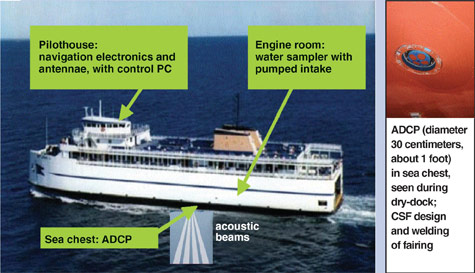How does it work?

- Horizontally-directed currents are measured in a vertical profile, from near the sea surface to near the seafloor, many times each minute by an acoustic Doppler current profiler (ADCP) mounted in a sea chest
(cavity within, and flush with, the hull) on the underside of the vessel..
- The ADCP sends and receives sound pulses to measure water movement relative to the ship. This information is combined with accurate vessel navigation data to determine the speed and direction of water, relative to land, in each depth layer.
- Near-surface water is pumped past sensors in the engine room and its temperature, salinity, and chlorophyll concentration are measured.
- A cellular modem is used to operate the control computer remotely from shore, and to transfer data to shore for processing and archiving.
|